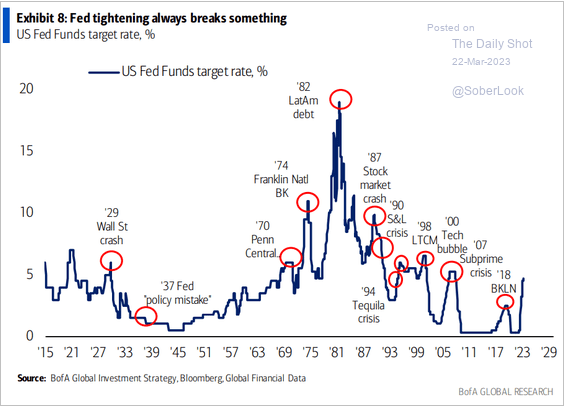Quarter point – one and done? — Fed Meeting of March 22, 2023

Fed Meeting
March 22, 2023
The last?
The two-day FOMC meeting concluded this afternoon. The Fed voted unanimously to increase its target for the federal funds rate to a range between 4.75% and 5%. Today’s increase is the second quarter percent increase in as many meetings and the ninth since the Fed began this rate increase cycle a year ago today. The nine increases represent the fastest rate of increase in the federal funds rate since the early 1980s. Recall that one year ago short-term rates hovered between zero and one-quarter of a percent.
The press release replaced “Russia’s war against Ukraine is causing tremendous human hardship” with “The U.S. banking system is sound and resilient.” The statement left open the possibility of additional increases, using the phrase “some additional policy firming may be appropriate.” No change was made to the quantitative tightening program; the Fed will continue to shrink its balance sheet.
No pause
Chairman Powell started his press conference referencing the recent bank failures and asserting that the banking system is “sound.” Questions about Silicon Valley Bank received an answer that SVB had a very narrow and connected depositor base. He focused more on inflation, reminding the audience that the Fed is committed to reaching its 2% inflation goal. The Committee believes that goal should be reached some time in 2026. He noted that the Committee expects unemployment to rise from 3.5 to 4.5% by the end of this year. Their projection of 4.6% in 2024 implies that the economy will continue to slow and job layoffs will mount.
The Chairman also addressed whether the Committee considered other rate paths. He stated that the Committee considered taking a pause in increasing rates but that raising rates was a unanimous decision. Whether or not this is the last increase in this cycle is an open question. The Committee’s projection is for fed funds to average 5.1% at the end of this year. Another quarter percent increase from today’s 5% upper bound would hit that average.
Comment
Short-term rates are now at their highest level since September 2007. Continued slowing in the economy and the recent failures of niche banks gave rise to the argument that the Fed has raised rates far enough. Certainly, yields on Treasury Bills and money market funds have caused some deposits to leave a few banks for those higher yielding alternatives. This money movement was a key driver in the demise of Signature and Silicon Valley Bank.
“Hike 'til you break something” is a Wall Street dig at the Fed. A brief review of rate increases over the last century would suggest that phrase has merit.

Source: The Daily Shot & BofA Global Research
Bank failures have also moved the Fed and other central banks to increase liquidity and funds available to the banking system. The uncertainty caused markets to move back and forth, especially the U.S. Treasury market. Short and intermediate maturity Treasuries swung up and down in one percent moves since early February. At this writing the two-year Treasury has moved down in yield just below 4%. The two-year is used as a gauge of where short-term rates may be in two years. The median view of the Committee projections then is a noticeably lower 3.1%. If inflation remains sticky above 4% this year, we expect the Fed’s projections to move up towards the two-year yield.
Summary
The current FOMC leadership has done an admirable job of telegraphing its policy moves and being deliberate about implementing them. A cut in interest rates would have worried markets that “the Fed knows something bad and is not telling us.” A pause would have shifted focus from inflation to the banking system. Staying the course in rate increases was probably the least bad course after the last two weeks of market uncertainty. The full effects of this year’s rate increases have not impacted the economy.
Economic data from industrial and manufacturing sectors continues to weaken. Financial conditions for all borrowers continue to tighten. The service sector continues to be a bright spot. With a tight labor market, we do expect the service sector to follow manufacturing activity lower in the coming months.
Thank you for trusting our team, and please let us know if you have any questions.
Steve Orr is the Executive Vice President and Chief Investment Officer for Texas Capital Bank Private Wealth Advisors. Steve has earned the right to use the Chartered Financial Analyst and Chartered Market Technician designations. He holds a Bachelor of Arts in Economics from The University of Texas at Austin, a Master of Business Administration in Finance from Texas State University, and a Juris Doctor in Securities from St. Mary’s University School of Law. Follow him on Twitter here.
The contents of this article are subject to the terms and conditions available here.